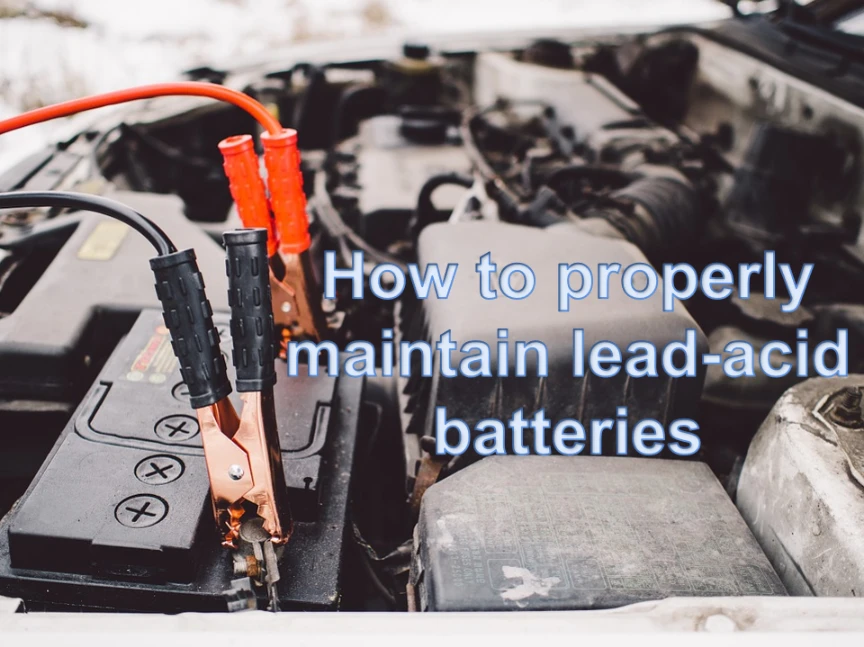
As a rechargeable battery, lead-acid batteries are the most commonly used type of battery in photovoltaic systems. Lead-acid batteries can be seen everywhere on the market, and they are used in many places. Most of them are used in cars, inverters, backup power systems, etc. Since we use lead-acid batteries, we need to understand how to maintain them in daily life. The battery can make it more durable in terms of service life, so there will be no problems when it is less than the service life.
Types of lead-acid batteries
By knowing different types of lead-acid batteries, not only can you improve your understanding of lead-acid batteries, but you can also maintain them accordingly.
1. VRLA battery
VRLA stands for Valve Regulated Lead Acid, also known as Sealed Lead Acid. They are created by using a limited amount of electrolyte, which is absorbed in the plate separator or forms a gel. The negative and positive plates have a ratio so that the oxygen is recombined within the cell, and there is an overflow valve that retains the cell contents regardless of cell position.
- Application: Suitable for UPS, wind and solar power storage, telephone exchanges, ship communication lighting, power stations and other places that require DC power.
- Features: The grid adopts high-quality high-tin and low-calcium quaternary alloy, which reduces the internal resistance of the battery and improves the deep cycle performance and service life of the battery. It has good voltage consistency, high gas recombination efficiency, low self-discharge, reliable sealing, etc
2. Tubular battery
Tubular batteries are also known as tubular lead-acid batteries because they are made of fiberglass tubes. These tubes contain lead oxide and red LED powder and are sealed with plastic fittings. This tubular electrode design enhances its performance and is a common battery for applications such as UPS and inverters. Tubular batteries have a positive plate that sits inside a cloth-wrapped tube that holds power to its electrodes.
- Application: Backup power for telephone exchanges and large factories, material handling trucks, tractors, mining vehicles, and today are widely used in inverter and UPS applications.
- Features: The positive plate is a tubular plate, which can effectively prevent the active material from falling off. The negative plate is a paste-coated plate. The special grid structure design improves the utilization rate of active materials and the large current discharge capacity and has a strong charging acceptance ability.
3. Start-stop battery
The start-stop battery is a lead-acid battery designed for starting a car engine. It mainly replaces the original plastic separator with an ultra-fine glass fiber separator. This battery is designed for maximum surface area, higher corrosion resistance, lower internal resistance, and higher deep discharge current allowing frequent high current discharges for short periods of time.
- Application: Suitable for starting, ignition, and lighting of internal combustion engines for various automobiles, tractors, ships, and offshore platforms.
- Features: Reliable quality, large capacity range, easy maintenance, reliable low temperature starting performance, good vibration resistance, low water loss, and so on.
So, for lead-acid batteries, how should we properly maintain them?
At present, most lead-acid batteries on the market are maintenance-free batteries. Although they are called maintenance-free batteries, they also have common faults. Common faults include plate vulcanization, leakage, and insufficient power storage. These faults will cause rechargeable batteries. In order to keep the battery in good condition, correct maintenance and maintenance are necessary, so as to achieve the purpose of prolonging the battery life. After all, the maintenance of the battery is cheaper than the replacement of the battery. The following describes the maintenance methods of different types of lead-acid batteries.
How to maintain VRLA battery?
- Regularly conduct discharge tests on it to detect the capacity of the battery to avoid failure to function as a backup power source due to its capacity drop
- Keep the tops of the batteries clean to keep them from getting dusty
- Check the battery’s state of charge, if your batteries have not reached 100% SoC after a full charge cycle, they may be defective, damaged, or have reached the end of their useful life.
How to care for tubular batteries?
- Always store and install batteries in a ventilated space, and it is important to maintain cool temperatures to reduce battery heat generation.
- Keep the surface of the battery clean, especially the positive and negative poles should be wiped clean to prevent rust and ensure the normal operation of the battery
- Keeping batteries away from hot environments (such as fires, near heaters, or in direct sunlight) can help extend battery capacity and prevent them from exploding
How to maintain the start-stop battery?
- Don’t leave the car unused for extended periods of time, there are many components in your car that continue to draw power from the car when the car is off, which could end up with a dead battery if you don’t drive for weeks.
- Hold the battery firmly, vibration can shorten the life of the start-stop battery, and if it is not held firmly, excessive vibration can damage the internal components of the battery – causing short circuits and shortening battery life.
JYC lead-acid battery
As one of the storage battery companies, JYC has the strictest quality control standards. The raw materials of the products are carefully selected, and each stage of production is also strictly controlled to ensure that the batteries are free of material or process defects and ensure the high quality of the batteries. All batteries are specially inspected and fully charged before being shipped to customers, preventing the batteries from running out of power when they arrive.



